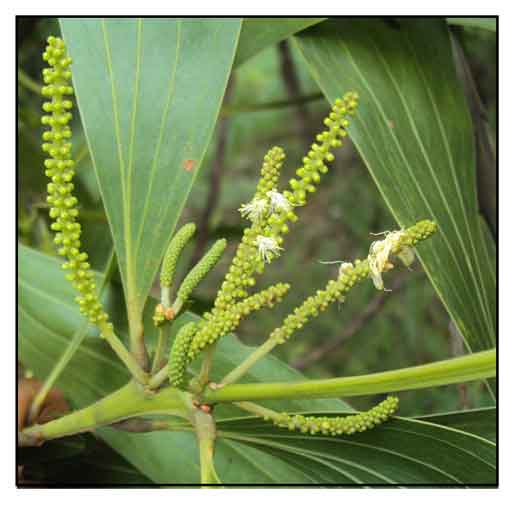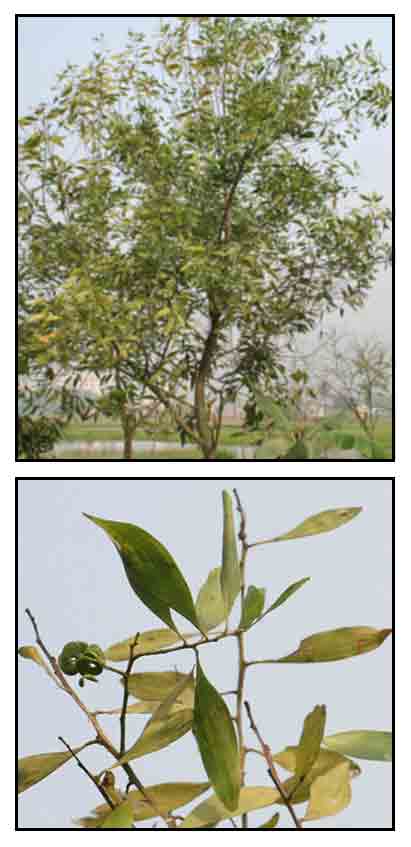 Botanical snippet Botanical snippet
- Etymology: The genus name derives from the Greek word "akis", meaning a point or a barb.
- It was originally described by Rumph as Mangium montanum, but changed to an acacia in 1806.
- Species name alludes to its resemblance to "mangge" (mangroves in Indonesia). (3)
Botany
Acacia mangium is a single-stemmed evergreen tree or shrub growing to a height of 25-35 meters. often with a straight trunk. Young trees have smooth, greenish bark, fissures developing at 2-3 years age. In older trees, bark is rough, hard, fissured near the base, greyish-brown to dark brown; inner back is pale brown. Bole of older trees are branchless up to 15 meters. Inflorescence is composed of many tiny white flowers in spikes. Flowers are quinqeufloral. Calyx is 0.6-0.8 mm long, with obtuse lobes, and corolla 1.2-1.5 mm long. Pods are broad, linear, and irregularly coiled when ripe, membranous or slightly woody, inconspicuously veined, 3-5 millimeters wide and 7-10 centimeters long. Seeds are black and shiny, longitudinal, elliptical, ovate to oblong, 3-5 millimeters by 2-3 millimeters, longitudinally arranged and attached to to pods by an orange or red utricle. (3)
Distribution
- Exotic in the Philippines.
- Also exotic in Malaysia, South Africa, Thailand, Vietnam.
- Native to Australia, Indonesia, Papua New Guinea. (3)
- Genetic improvement programmes have been undertaken in the Philippines, Australia, India, Indonesia, Malaysia, Taiwan, and Thailand. (5)
- Popular species for forest plantation and agroforestry projects. (12)
 Constituents Constituents
- Ethanolic extract of leaves yielded high levels of flavonoids (483.70 ± 3.08 mg/g) and tannins (116.75 ± 9.24 mg/g). (see study below) (7)
- Condensed tannin oligomers from A. mangium were shown to be heterogenous mixtures consisting of procyanidin and prodephinidin structural units with polymerization degrees up to 9.
(8)
- Gum yields 5.4% ash, 0.98% N, 1.49% methoxyl, and32.2% uronic acid. After hydrolysis, sugar composition yielded 9.0% 4-0-methylgucoronic acid, 23.2% glucoronic acid, 56% galactose, 10% arabinose, and 2% rhamnose. (12)
Properties
- High in crude protein; low in vitro dry matter digestibility. (3)
- Studies have suggested antidiabetic, antioxidant, antiproliferative, molluscicidal properties.
Uses
Edibility
- Germinating seeds can be cooked and eaten as vegetable. (3)
Folkloric
- No reported folkloric medicinal use in the Philippines.
Others
- Fodder: Young shoots and leaves browsed by buffalo and cattle.
- Fuel: Provides good quality charcoal; suitable for briquettes and artificial carbon. Yield a calorific value of 4,800-4,900 kcal/kg. (3)
- Wood: Used for construction, boat building, furniture and cabinet making, turnery, floors, particle board, fence post. Also used in pulp and paper making. Feasible conversion into veneer and plywood. Unsuitable as timber because of high rot and termite attacks. Prone to heart rot caused by white fungi. (3) (5)
- Tannin: High tannin content (18-39%), suitable for commercial application. (•) Acacia mangium bark extracts can be used to produce tanned leather base on the proanthocyanidins (PAs)-protein interaction, which transforms biodegradable raw hide into leather. In China, large quantities of bark are currently being wasted. (see study below) (6)
Studies
• Tannin Use in the Philippines: Study aimed to identify tree species in the country with high tannin content as a potential source of developing tannin-based adhesive for fiber board of coconut or bamboo as a cheap and reliable alternative to low cost housing construction. Of seven species selected, four species were identified for tannin production, in order of priority: Acacia mangium, L. leucocephala, B. malabarica, and S. macrophylla. Of the four tannin-producing species, only Acacia mangium is in the top four wood-producing species. (4)
• Antidiabetic Potential / Proanthocyanidins / Bark: Study of proanthocyanidins from ethanol extracts from barks of Acacia mangium and Larix gmelinii showed potential antidiabetic properties. A significant relationship between carbolytic enzymes inhibition and degree of polymerization was established. The degree of polymerization is a major contributor to the biologic activity of proanthocyanidins from both types of woody plant bark. (6)
• Antioxidant / Antiproliferative
/ Leaves: Study evaluated the antioxidant and antiproliferative activities of Acacia mangium Willd. foliar ethanolic extract. Antioxidant activity was evaluated by ABTS, ferrous ion chelating activity, and ß-carotene/linoleic acid system. In vitro antiproliferative activity was analyzed against Sarcoma 180 tumor cell line by MTT assay. Results showed high level of flavonoids and tannins, and strong antioxidant activity in ABTS and ß-carotene assays and showed reduction of Sarcoma 180 cells viability. (see constituents above) (7)
• Phenolic Compounds / Antioxidant Activity / Bark: The bark of A. mangium yield high concentrations of phenolic compounds. A significant linear relationship was observed between antioxidant potency, antiradical activity, and content of phenolic compounds of bark extracts. (8)
• Antimicrobial / Antioxidant / Leaves: Study screened various extracts of A. mangium leaves for antimicrobial and antioxidant activities. A methanol extract showed strong antioxidant activity by DPPH assay, followed by acetonitrile extract, and least in the n-hexane extract. In disc diffusion assay, only the methanol extract exhibited dose-dependent inhibitory activity against E. coli with MIC of more than 20 mg/mL. The inhibitory activity was bacteriostatic. High total phenolic content (3.56 g of gallic acid equivalent [GAE] per 100 g of extract) confirmed an associated with both antimicrobial and antioxidant activities. (9)
• Molluscicidal / Saponin / Bark: Phytochemical screenings of A. mangium methanol extract of leaves, flower, and bark yielded a saponin, reported to be toxic to snails. The bark was used to evaluate the molluscicidal activity against GAS (golden apple snail) using a dip bio-assay experiment. An aqueous extract showed 100% mortality at concentration of 50 mg/ml within 24 hours. An LC50 was recorded at 25 mg/ml. (10)
• Wood-Cement Composites: A combination of compounds including a cost-effective accelerator (CaCl2 or MgCl2) and an efficient chelating agent containing ions of Al, Sn, or Fe may have considerable synergistic effects and may potentially enable wood cement composites to be manufactured from A. mangium. (11)
Availability
- Wild-crafted.
- Cultivated.
|

![]()





